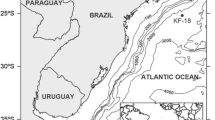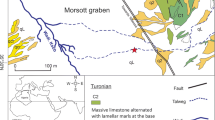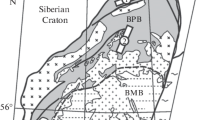Abstract
The U-series component-dating method has been employed to date the sediment core B194 from Balikun Lake.230Th/232Th and234U/232Th ratios in various components of the samples dissolved in different concentration acids were measured respectively. The results indicate that there is a good relationship of the isotopic ratios between the solutions and the residues, and that uranium and thorium isotopic fractionations did not occur during acid leaching. Based on the U-series ages obtained by using component-dating method, a 144-ka time sequence was established corresponding to the upper 25-m interval of the B194 core, which is in agreement with palaeomagnetic dating results. The fact that the palaeoclimatic and palaeoenvironmental record labeled with U-series ages is correlative with the deepsea °18O SPECMAP also demonstrates that the U-series component-dating method can be used to date lake sediments.
Similar content being viewed by others
References
Ivanovich, M., Harmon, R. A.,Uranium-Series Disequilibrium: Applications to Earth, Marine, and Environmental Sciences, 2nd ed., Oxford: Clarendon Press, 1992, 566–569.
Luo, S. D., Ku, T. L., U-series isochron dating: A generalied method employing total-sample dissolution,Geochim. Cosmochim. Acta, 1991, 55(20): 555.
Phillips, F. M., Ku, T. L., Huang Q.et al.,230Th/234U and36Cl dating of evaporate deposits from the Western Qaidarn Basin, China: Implications for glacial-period dust export from Central Asia,Geological Society of Amrican Bulletin, 1993, 105: 1606.
Szabo, B. J., Bush, C. A., Uranium-series dating of carbonate (tufa) deposits associated with Quaternary fluctuations of Pyramid Lake, Nevada,Quat. Res., 1996, 45(3): 271.
Marcel, C. H., Ghaleb, C., Gariepy, C.et al., U-series dating by the TIMS technique of Land Snails from paleosols in the Canary Islands,Quat. Res., 1995, 44(2): 276.
Ludwing, K. R., Titterington, D. M., Calculation of230Th/U isochrons, ages and errors, Geochim,Cosmochim. Acta. 1994, 58: 5031.
Xia Ming, Zhang Chenghui, Ma Zhibang, Studies on uranium palaeoanthropologic and series dating of peat samples,Quaternaria Sinica (in Chinese). 1989. 8(1): 17.
Han Shuti, Yuan Yujiang. The sequence of palaeoclimatic variation of Balikun Lake of Xinjiang in the past 35 000 years,Acta Geogmphica Sinica (in Chinese), 1990, 45(3): 350.
Xia Ming, Discussion on results of the uranium-series intercomparison project,Scientia Geologica Sinica (in Chinese), 1984. (1): 13.
Imbrie, J., Hays, J., Martinson, D.et al., The orbital theory of Pleistocene climate: support from a revised chmmlogy of the Marine Delta18O record, inMilankovitch and Climate (eds. Berger, A. L.et al.), Dordrecht: Reidel Publishing Company, 1984, 269–305.
Author information
Authors and Affiliations
About this article
Cite this article
Liu, J., Ma, Z. U-series dating on late Quaternary sediments from Balikun Lake. Chin.Sci.Bull. 43, 1434–1441 (1998). https://doi.org/10.1007/BF02884120
Received:
Issue Date:
DOI: https://doi.org/10.1007/BF02884120




